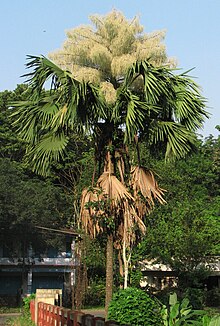Corypha umbraculifera
| Talipot palm | |
|---|---|
 |
|
| Talipot palm flowering at Kerala, India | |
| Scientific classification | |
| Kingdom: | Plantae |
| (unranked): | Angiosperms |
| (unranked): | Monocots |
| (unranked): | Commelinids |
| Order: | Arecales |
| Family: | Arecaceae |
| Genus: | Corypha |
| Species: | C. umbraculifera |
| Binomial name | |
|
Corypha umbraculifera L. |
|
| Synonyms | |
|
|
Corypha umbraculifera, the talipot palm, is a species of palm native to eastern and southern India and Sri Lanka. It is also grown in Cambodia, Myanmar, China, Thailand and the Andaman Islands. It is a flowering plant with the largest inflorescence in the world. It lives up to 60 years before bearing fruits and flowers. It dies shortly after.
It is one of the largest palms with individual specimens having reached heights of up to 25 m (82 ft) with stems up to 1.3 m (4.3 ft) in diameter. It is a fan palm (Arecaceae tribe Corypheae), with large, palmate leaves up to 5 m (16 ft) in diameter, with a petiole up to 4 m (13 ft), and up to 130 leaflets.
The talipot palm bears the largest inflorescence of any plant, 6–8 m (20–26 ft) long, consisting of one to several million small flowers borne on a branched stalk that forms at the top of the trunk (the titan arum, Amorphophallus titanum, from the family Araceae, has the largest unbranched inflorescence, and the species Rafflesia arnoldii has the world's largest single flower). The talipot palm is monocarpic, flowering only once, when it is 30 to 80 years old. It takes about a year for the fruit to mature, producing thousands of round, yellow-green fruit 3–4 cm (1–1.5 in) in diameter, each containing a single seed. The plant dies after fruiting.
The talipot palm is cultivated in South India and Sri Lanka. It is also cultivated in Southeast Asian countries of Cambodia, Myanmar, Thailand and the Andaman Islands. It is also grown sparsely in China.
...
Wikipedia

